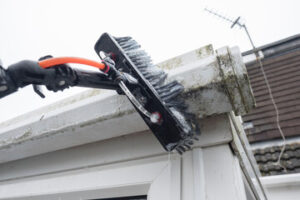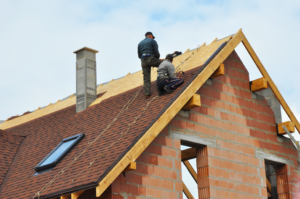Clogged gutters prevent rainwater from draining away from your home, leading to damage to the roof, walls and foundation. St. Louis Gutter Cleaning helps to protect your home from water damage and prevents costly repairs in the future.

A high-pressure cleaning tool, which attaches to your garden hose, can be used to blast away the gunk. It includes clever nozzles that fit snugly onto your gutter system to release a powerful jet of water that dislodges tough clogs.
The proliferation of awareness about personal safety, along with innovations in tools and equipment, has changed the landscape of gutter cleaning practices. Despite these advances, fundamental precautions remain crucial to safeguarding individuals against injuries during this task. From selecting the right equipment to understanding environmental conditions that can affect safety, proper preparation and attention are critical.
When performing gutter cleaning, it is important to protect yourself from injury by wearing gloves, eye protection and sturdy shoes with rubber soles. Gloves help to protect the hands from dirty, rotting leaf debris that often contains bird, pigeon and squirrel droppings rife with bacteria. Additionally, the scraping process can expose rusty metal to the hands, which can result in painful cuts. Gloves also prevent the fingers from being torn by twisted bits of loose metal. It is a good idea to use thick leather gloves rather than cotton or thin, rubber gloves.
It is also recommended to wear a face mask and ear protection. Gutter debris can contain insect and animal nests as well as twigs, seeds, leaves and other materials that could be thrown in your eyes or ears. Additionally, you will likely encounter frogs, birds, rats and other animals that may leave stinging flies behind when you are breaking up their clogs in your gutters. In these instances, eye and ear protection can save you from the pain of stings and screams.
Before beginning the cleaning process, it is a good idea to inspect the ladder and ensure that it is stable. Always place the ladder at a safe angle and do not exceed the maximum load capacity of the ladder. The ladder should also be secured to the ground with a tether or rope and be placed in a position that is a safe distance from power lines and other hazards.
It is also a good idea to clean the roof first before moving onto the gutters. Raking the roof before cleaning can help to keep large pieces of debris from falling and causing damage. Furthermore, it can help to prevent clogging in valleys, near chimneys and heating, ventilation and air conditioning (HVAC) equipment.
Curb Appeal
A home’s exterior is the first thing visitors and potential buyers see, which means it plays a crucial role in creating a positive impression. From well-groomed lawns and vibrant flowers to fresh paint jobs, there are many ways you can improve the curb appeal of your property. Gutter cleaning is another easy and effective way to boost your home’s appearance, and it can also play a significant role in preserving its value over time.
Gutter cleaning involves removing leaves, dirt, and debris from gutters to ensure proper water flow. Regular gutter cleaning prevents clogs and water damage to your siding, foundation, and landscaping. It also extends the lifespan of your gutters and saves you money on repairs or replacements. Additionally, regular gutter cleaning prevents moss and algae growth, which can compromise the structural integrity of your roof.
When gutters are full of dirt and debris, rainwater will overflow and cause unsightly stains on the side of your home. This can lead to mold and mildew growth that degrades the overall look of your home. It may also cause the foundation of your house to crack and shift, which could result in costly repair work down the road.
Moreover, clogged gutters can create standing water that attracts pests like mosquitoes and rodents. These pests can carry disease-causing pathogens, which can be dangerous to your family’s health. Gutter cleaning removes pests and their nesting places, reducing the risk of infestation and disease.
As a homeowner, you should always aim to keep your house in good condition. Aside from enhancing your property’s aesthetics, it can also increase its resale value and make it a better place to live. Fortunately, pressure washing and gutter cleaning services can help you achieve this goal. By removing harmful substances and preventing damages to your property, these services can make your home safer and more attractive to prospective buyers. So, don’t wait any longer – call a professional today to clean your house’s gutters and protect its value. A reputable company will offer quality services at a reasonable price. Contact us to get started!
Reputation
Gutter cleaning professionals are committed to a high level of customer service. They listen carefully to customers’ concerns and answer any questions thoroughly. They also offer advice on how homeowners can maintain their gutters between professional cleanings. This helps homeowners feel confident in their ability to keep their property well-maintained and extend the life of their gutters.
Gutters play a vital role in protecting homes, directing rainwater away from foundations and basements to prevent structural damage. They are often neglected because they’re out of sight and out of mind, but regular cleaning prevents clogs that can lead to water damage. Moreover, clean gutters increase the value of properties, as they provide a smooth and safe drainage system.
Clogged gutters can cause water to overflow and seep into basements and foundations, causing damage and leading to expensive repairs. In addition, clogged gutters can attract pests and lead to mold growth.
Homeowners may be tempted to do DIY gutter cleaning, but this is not recommended as it can be dangerous. Ladder accidents account for 9 million emergency room visits each year, and this number increases when workers lack proper training or equipment. Climbing a ladder without the proper safety gear can result in serious injuries, including head trauma and spinal cord injuries. Additionally, gutter cleaning is a hazardous job for people with weakened backs or necks. Professional gutter cleaners have the training, expertise and equipment to safely complete the job.
Professional gutter cleaners use a variety of tools to ensure a thorough job, such as ladders, gutter scoops, high-powered pressure washers and safety harnesses. They also perform a visual inspection before beginning the work, identifying any areas of concern and ensuring that they address them accordingly. In addition, they dispose of debris responsibly to minimize environmental impact. They may compost or recycle organic material and avoid landfills when possible. In doing so, they help reduce soil erosion and contribute to a sustainable ecosystem. They also support the local economy by reducing waste and promoting green practices. In addition, they help homeowners save money by preventing costly repairs and extending the lifespan of their gutters.
Repairs
A gutter system channels rainwater from the roof to the ground, preventing water damage to your home’s walls and foundation. Gutter cleaning consists of removing debris, including leaves, twigs, and dirt, to keep the water flowing properly. It also involves testing each downspout to make sure it’s clear of clogs. If the downspouts are clogged, they may need to be snaked out or flushed with a garden hose. Gutter cleaning should be performed twice a year, preferably in spring and autumn.
Aside from the obvious benefits of curb appeal and improved home value, regular gutter cleaning protects landscaping projects, averts basement flooding, and prevents soil erosion. It also reduces the potential for termite infestation, mold growth, and other pest problems. In addition, it helps maintain the structural integrity of your house and extends its lifespan.
Gutter cleaning also involves a thorough inspection of the gutters, downspouts, and the surrounding landscape. A professional will check for rust, leaks, and signs of decay or rot. He or she will also check for loose gutter brackets and spikes, which are typically fastened to the fascia boards with hex bolts, and look for cracks in the gutter. If there are any cracks, the gutter will need to be replaced.
Finally, a professional will inspect the gutters around the power lines to make sure the protective wire insulation isn’t rubbed off by wind and other elements. If it is, the professional will need to call an electrical contractor to replace the insulation and fix any damage to the downspout or gutter.
The best time to perform a gutter inspection is in the fall, as this is when many plants have already gone dormant for the winter. However, regular inspections are important throughout the year. Especially if your property is plagued by overhanging branches, aggressive wall climbing plants, or has a north facing roof with moss build up. A professional can quickly assess these issues with a high access inspection camera on a telescopic pole, from the safety of the ground. This is much faster and safer than trying to do it with a ladder.
